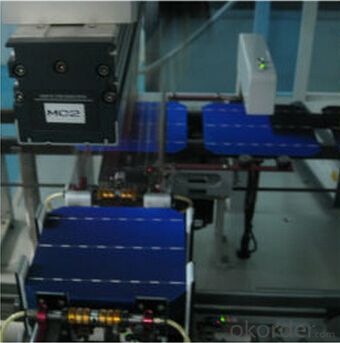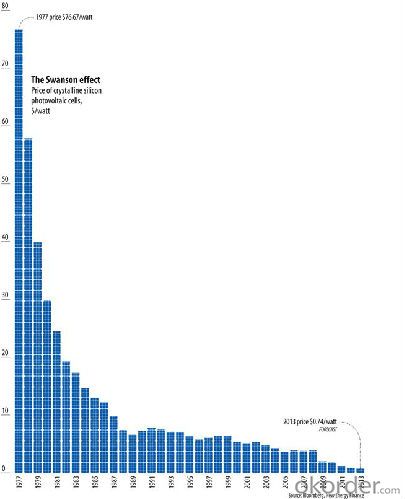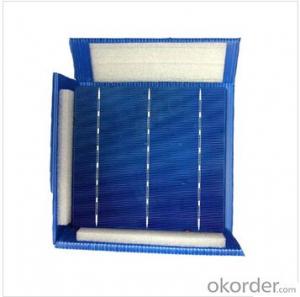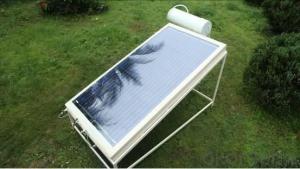Polycrystalline Solar Cells Series- CM16.80
- Loading Port:
- Shanghai
- Payment Terms:
- TT or LC
- Min Order Qty:
- 3000 pc
- Supply Capability:
- 300000 pc/month
OKorder Service Pledge
OKorder Financial Service
You Might Also Like
Solar Cells:
Solar cells is made by solar wafer, it has three categories of solar cell right now, monocrystalline polycrystalline and thin film,These cells are entirely based around the concept PN junction, which is the critical part of solar module, it is the part that can convert the light energy into electricity, the thickness is from 180um to 200um, with even busbars to conduct electricity, textured cell can decrease diffuse reflection; they are often electrically connected and encapsulated as a module. Photovoltaic modules often have a sheet of glass on the front (sun up) side, allowing light to pass while protecting semiconductor wafers from abrasion and impact due to wind-driven debris, rain, hail, etc. Solar cells are also usually connected in series in modules, creating an additive voltage. Connecting cells in parallel will yield a higher current;With high quality and stable quality. Our Cells can greatly improve the performance of Solar Modules.
Features:
1. High conversion efficiencies resulting in superior power output performance.
2. Outstanding power output even in low light or high temperature conditions
3. Optimized design for ease of soldering and lamination
4. Long-term stability, reliability and performance
5. Low breakage rate
6. Color uniformity
Solar Cells Advantage:
1. Tire-1 Solar Cells’ Manufacturer Quality Guarantee. With a complete and sophisticated quality government system, our Quality Management have arrived world’s leading place. Customer can receive Tire-1 Cells Maker’s Quality Standard Products.
2. Trusted Warranty. We can supply trusted after-sales service to our customer. If our cells are found not in conformity to the specification of manufacturer, or should the inspected quantity found in shortage, or should the packing found damaged, the buyer has the right to claim to the seller. The claim, if any, should be presented to seller within 30 days after cargo's arrival date to the port, together with related inspection report and photos issued and provided by a reputable independent surveyor such as SGS.
3. World’s Leading Manufacturer Equipment. We imported the newest and leading production equipment from abroad. Advanced equipment can guarantee the stable quality of cells. Auto production line can also save labor cost which will further cut our production cost.
4. Bulk supply: With the production capacity of 500MW, we can produce large quantity every month. This can satisfy most customer requirement.
Specifications:
Kit content:
Product: multicrystalline cell based on poly silicone
Format: 156mm*156mm ± 0.5mm
Front contacts (-): 3*1.5mm wide bus bars(silver), acid texturized surface, blue silicone nitride antireflection coating
Back contacts (+): 3*3mm wide bus bars(silver/aluminum), aluminum backside metallization
Warranty:
Repairs: For repairs please contact to us
Exchange service: You can choose between a refund, exchange or credit where goods are faulty or doesn’t do what it supposed to do
Model | CM16.80% |
Max power | 4.1W |
Short-circuit current(Isc) | 8.41A |
Imax at 0.5V | 8A |
Open circuit voltage(Voc) | 0.62V |
Size | 156*156mm |
Efficiency | 16.80% |


FAQ
We have organized several common questions for our clients,may help you sincerely:
①What price for each watt?
It depends on the efficiency of the solar cell, quantity, delivery date and payment terms.
②How long can we receive the product after purchase?
In the purchase of product within three working days, We will arrange the factory delivery as soon as possible. The pecific time of receiving is related to the state and position of customers.Commonly 7 to 10 working days can be served.
③Can you provide the peripheral products of the solar panels, such as the battery, controller, and inverter? If so, can you tell me how do they match each other?
Yes, we can, we have two companies for solar region, one is CNBM International, the other is CNBM engineering Co.
We can provide you not only the solar module but also the off grid solar system, we can also provide you service with on grid plant.
④What is your warranty of solar cell?
Our product can promise lower than 0.3% open box crack, we support claim after opening the box if it has crackm color difference or sth, the buyer should give pictures immediately, we can not accept the claim after the solar cell has assembled to solar panel.
• Timeliness of delivery
• ⑤How do you pack your products?
We have rich experience on how to pack the solar cell to make sure the safety on shipment, we could use wooden box or pallet as buyer's preference.
How Much Do Solar Panels Cost
How much do solar panels cost? This is undoubtedly the question we`re asked the most, and unfortunately it has no straightforward answer. We decided to pull together all aspects of this question, and write the best resource on the costs of solar panels you will find on the entire Internet.
Residential solar systems are typically sized from 3 to 8kW and end up costing between $15,000 and $40,000. The cost per watt (price inclusive of parts, labor, permitting fees, overhead, and profit) has decreased significantly over the last decade and is now between 6 and 8 ($/W) in many parts of the U.S. Generally, the bigger the system, the lower the cost per watt.
The total costs are split into system, installation and operational costs, roughly in the following ratios:
Contents

How Much Do Solar Panels Cost Today?
Solar panels themselves are now a global product. There’s tremendous variation in the cost of solar panels based on the type and efficiency of the solar panels. However, the type of panels used for residential solar installations is quite standard and the costs are basically set globally. That cost has fallen tremendously within the past few years — they’re now about half the price they were in 2008, and more than 100 times lower than they were back in 1977.
The average weekly spot price for polysilicon solar modules this week is $0.55/watt. For a thin-film solar modules, it’s $0.55/watt. For residential solar modules, which are typically of a higher efficiency than solar modules used in utility-scale solar farms, the figure would be a bit higher. But how much does this solar cost info really help you?

- Q:I bought a new poly solar cells, and the test result of the conversion efficiency is 16.8%, is it lower than usual?
- The PV solar cells should be around 18%, any solar cells under that rate is not very efficient.
- Q:Can solar cells be used in disaster relief or emergency response situations?
- Yes, solar cells can be used in disaster relief or emergency response situations. They provide a reliable and sustainable source of electricity, especially in areas where the power grid has been disrupted or damaged. Solar cells can be used to power communication systems, emergency lighting, medical equipment, and water purification systems, among others. Their portability and ease of installation make them an ideal solution in such situations, ensuring that critical services and infrastructure can continue to function even during emergencies.
- Q:Can solar cells be used in smart home automation systems?
- Yes, solar cells can be used in smart home automation systems. Solar cells can generate electricity from sunlight and can be integrated into the smart home system to power various devices and sensors. This allows for energy-efficient and sustainable operation of the automation system, reducing reliance on conventional power sources and lowering electricity costs.
- Q:What is the impact of solar cells on reducing energy inequality?
- Solar cells have a significant impact on reducing energy inequality by providing access to clean and affordable electricity for communities that are underserved or lack access to traditional power sources. By harnessing the abundant and renewable energy from the sun, solar cells facilitate the decentralization of energy production, enabling individuals and communities to generate their own power and reduce their dependence on centralized grids. This empowers marginalized communities to become energy self-sufficient, bridging the energy gap and promoting a more equitable distribution of energy resources. Additionally, solar cells contribute to mitigating climate change and reducing carbon emissions, which disproportionately affect vulnerable populations, further addressing energy inequality and promoting sustainable development.
- Q:Can a solar cell be used in commercial buildings?
- The answer is absolutely yes!
- Q:Can solar cells be used in hot climates?
- Yes, solar cells can be used in hot climates. In fact, solar cells are more efficient in hot climates due to increased sunlight and higher temperatures, which can enhance their overall performance. However, it is important to consider proper maintenance and cooling mechanisms to prevent any potential damage or decrease in efficiency caused by excessive heat.
- Q:Can solar cells be used in off-grid systems?
- Yes, solar cells can be used in off-grid systems. Off-grid systems typically rely on renewable energy sources, and solar cells are an ideal choice for generating electricity in such systems. Solar cells convert sunlight into electricity, which can be stored in batteries for use when the sun is not shining. This allows off-grid systems to power various appliances and devices without the need for a connection to the traditional power grid.
- Q:What is the role of solar cell inverters in grid-tied systems?
- The role of solar cell inverters in grid-tied systems is to convert the direct current (DC) energy generated by solar panels into alternating current (AC) energy that is compatible with the electrical grid. These inverters ensure that the solar energy produced by the panels can be used to power appliances and devices in homes or businesses, and any excess energy can be fed back into the grid for others to use. Additionally, solar cell inverters also provide important safety features, such as isolating the solar system from the grid during power outages to protect utility workers.
- Q:How do solar cells perform in areas with frequent thunderstorms?
- Solar cells can still operate effectively in areas with frequent thunderstorms. While thunderstorms can temporarily decrease solar cell performance due to reduced sunlight exposure, advancements in solar technology have made solar cells more durable and resistant to extreme weather conditions. Additionally, solar cells can still generate electricity from diffused sunlight during cloudy or stormy days. Overall, solar cells can still be a viable and sustainable energy option in areas with frequent thunderstorms.
- Q:How do solar cells perform in regions with high levels of dust and sandstorms?
- Solar cells may experience decreased performance in regions with high levels of dust and sandstorms. The accumulation of dust particles on the surface of solar panels can reduce their efficiency by blocking sunlight and reducing the amount of energy they can generate. Regular cleaning and maintenance of solar panels are essential in such environments to ensure optimal performance. Additionally, advancements in solar panel technology, such as anti-soiling coatings, are being developed to mitigate the impact of dust and sandstorms on solar cell performance.
1. Manufacturer Overview |
|
|---|---|
| Location | |
| Year Established | |
| Annual Output Value | |
| Main Markets | |
| Company Certifications | |
2. Manufacturer Certificates |
|
|---|---|
| a) Certification Name | |
| Range | |
| Reference | |
| Validity Period | |
3. Manufacturer Capability |
|
|---|---|
| a)Trade Capacity | |
| Nearest Port | |
| Export Percentage | |
| No.of Employees in Trade Department | |
| Language Spoken: | |
| b)Factory Information | |
| Factory Size: | |
| No. of Production Lines | |
| Contract Manufacturing | |
| Product Price Range | |
Send your message to us
Polycrystalline Solar Cells Series- CM16.80
- Loading Port:
- Shanghai
- Payment Terms:
- TT or LC
- Min Order Qty:
- 3000 pc
- Supply Capability:
- 300000 pc/month
OKorder Service Pledge
OKorder Financial Service
Similar products
New products
Hot products
Hot Searches
Related keywords





























